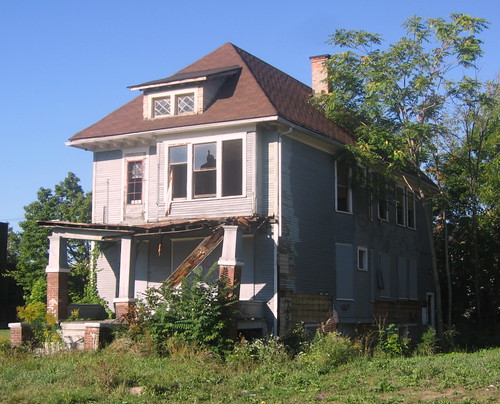First started writing about 1466 Michigan, long time ago - here in January 2005 within the context of vacant houses surrounding City schools and again here, in April 2006 and most recently in February 2007, here.
Problem of course is that no matter how many times I re-board and secure the back door, next time I check as I did early this morning, it's wide open. The larger problem is that it's part of a pattern of neglect. It probably doesn't take an advanced degree in urban planning to understand the importance of developing a well integrated plan to either moth-ball structures such as this - new roof went on a few years back - for the market to catch-up to the supply of structurally solid houses such as this - or, to demolish it.
It's City owned and sits directly outside my office window. Should have been listed for the special City Auction later this month on September 22 - details. Not a spectacular or architecturally significant spot, straight Buffalo three bedroom upper/lower house. Contractor friends say 50-60K to whip it into habitable space.
Stranger still is that it sits less than half a block away from the newly renovated Arts Academy, crown jewel in the recent joint school reconstruction project. Sort of fits in with other houses in the neighborhood, owned by Rev. Stenhouse - secretary/treasurer of Buffalo's Control Board - see Controlled Plan?Same problem exists in other neighborhoods, too. School House Project, from March 2005 is my first attempt to get my arms around this issue.
Meanwhile here's a map showing proximity of 1466 Michigan to the new Arts Academy.
Artspace • BAVPA • Tour d'Neglect - 2007 • Woodlawn Row Houses • faq • my flickr
the creativity exchange • CEOs for Cities


1 comment:
Here's a question for fixbuffalo and other agile minds focused on our city: Do the people with enough power to make decisions (such as trying a mothballing approach with public money) also have enough knowledge of urban preservation to choose well?
fixbuffalo highlights houses with largely intact roofs, indicating solid understanding of actual rehab issues. Given his field of study, he'd better know that.
Which other people have the same knowledge? Could there be grant money for a focused effort just on water damage issues? The initial focus can be educating the appropriate officials, with later focus on developing efficient techniques for weatherproofing and securing.
I'm sure this all seems rather naive. It just looks to me like most efforts will be small and individual until the folks who control government actions have a strong interest. One way to attract interest is to educate.
Post a Comment